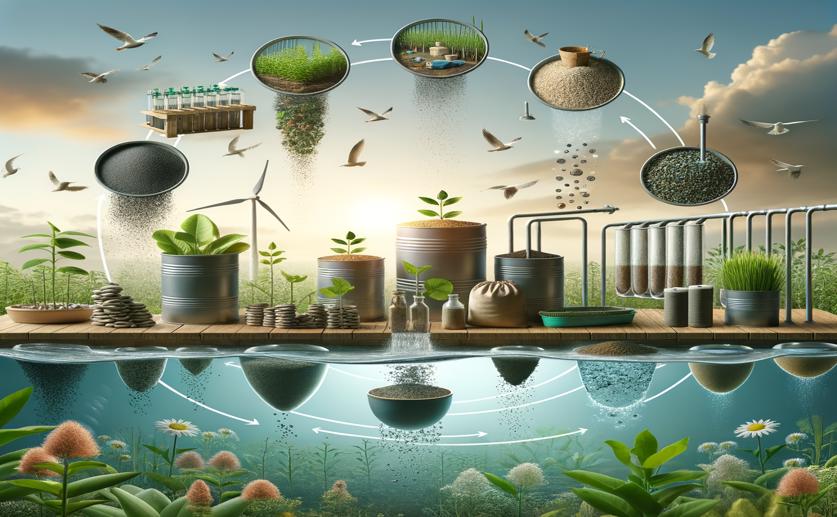New Eco-Friendly Fertilizers from Water Plant Waste Release Nutrients Slowly

Image Source: Natural Science News, 2024
Key Findings
- Researchers developed new fertilizers (nWTF1 and nWTF2) that release nutrients slowly, reducing pollution
- nWTF2 increased soil's water retention by 9.3 times compared to traditional fertilizers
- The nano-enabled fertilizers significantly boosted the growth and phosphorus content in maize plants
In the realm of modern agriculture, the quest for sustainable, efficient, and environmentally friendly fertilization methods is paramount. Excessive application of traditional fertilizers has led to environmental concerns such as pollution and the inefficient use of crucial nutrients. Addressing these issues, researchers from the City of Scientific Research and Technological Applications have developed a new type of fertilizer using the principles of nanotechnology[1]. This study presents a significant leap in fertilizer technology, potentially revolutionizing how we nourish our crops.
The innovation at the core of this research is the nano-enabled fertilizer (NEF), specifically two formulations referred to as nWTF1 and nWTF2. These fertilizers are created by combining nanostructured water treatment residuals (nWTR) with a blend of potassium dihydrogen phosphate (KH2PO4) and magnesium oxide (MgO) at different ratios. These components are mixed using a planetary ball mill, a device that grinds materials to a very fine, nano-scale powder.
The researchers extensively characterized the new fertilizers, examining their structure and properties. They then investigated their performance, focusing on water retention and the release of nutrients in both water and sandy soil. Impressively, nWTF2 increased the water retention capacity of sandy soil by 9.3 times compared to soil treated with conventional fertilizer after 26 days. Moreover, both nWTF1 and nWTF2 demonstrated slower and more sustained release rates of phosphorus (P), potassium (K), and magnesium (Mg) nutrients, a stark contrast to the rapid nutrient release and subsequent loss often seen with traditional fertilizers.
The slower release of nutrients is particularly beneficial as it reduces the risk of leaching, where nutrients are washed away before plants can absorb them, leading to pollution and wasted resources. The study suggests that the interaction mechanisms between the nutrients and the nWTR surface, along with the power function model, best describe the release kinetics of P, K, and Mg from the NEF in both water and soil.
In practical terms, the NEF was tested on Zea maize plants, a common crop, and compared with plants treated with commercial chemical fertilizers. The results were promising, with the nano-enabled fertilizers significantly promoting plant growth and increasing P content in the plants.
This recent advancement ties in with previous research that has explored similar themes. For instance, the use of water treatment residual nanoparticles (nWTRs) has been shown to be effective in stabilizing heavy metals in soils, reducing the mobility of contaminants like arsenic[2]. Furthermore, the development of polysaccharide-based materials for enhanced efficiency fertilizers (EEFs) has highlighted the importance of controlled nutrient release and the potential for biodegradable, non-toxic agricultural inputs[3]. The integration of Mg-enriched biochar has also demonstrated the benefits of slow-release fertilizers, contributing to sustainable agriculture by improving nutrient uptake efficiency in crops[4].
The current study builds upon these earlier findings by combining the concept of nano-scale materials with the need for efficient nutrient delivery systems. The NEF not only promotes plant growth but also embodies the principles of sustainability by reducing nutrient loss and environmental impact.
In conclusion, the novel nano-enabled fertilizers developed by the City of Scientific Research and Technological Applications represent a significant step forward in the pursuit of sustainable agriculture. By leveraging nanotechnology, these fertilizers offer a controlled and efficient delivery of essential nutrients, minimizing environmental pollution and enhancing crop production. This research underscores the potential of nanotechnology to create innovative solutions for the challenges faced in modern agriculture.
AgricultureSustainabilityBiotech
References
Main Study
1) Novel nano-fertilizers derived from drinking water industry waste for sustained release of macronutrients: performance, kinetics and sorption mechanisms.
Published 8th March, 2024
Journal: Scientific reports
Issue: Vol 14, Issue 1, Mar 2024
Related Studies
Related Articles





 18th January, 2024 | Jim Crocker
18th January, 2024 | Jim Crocker